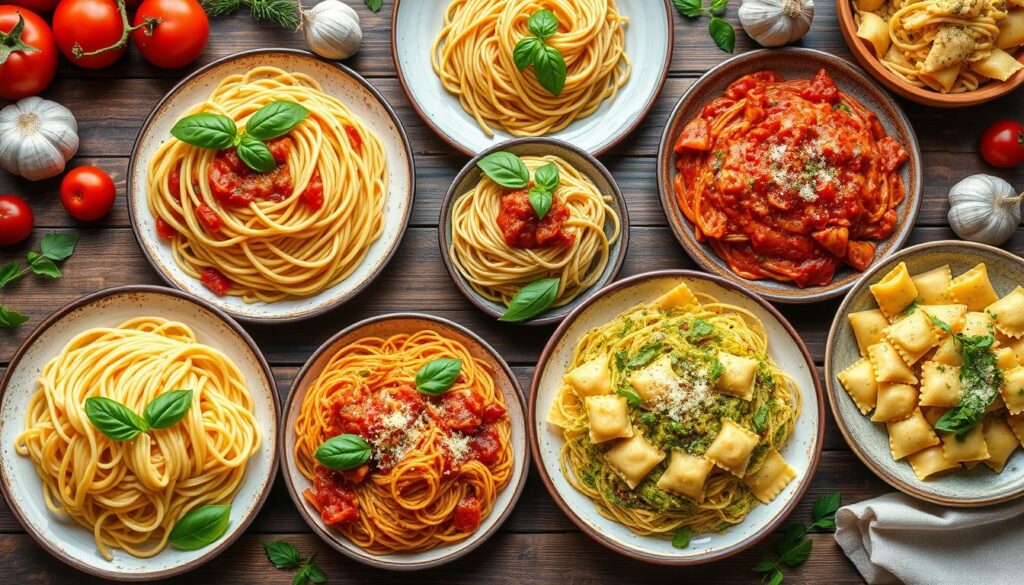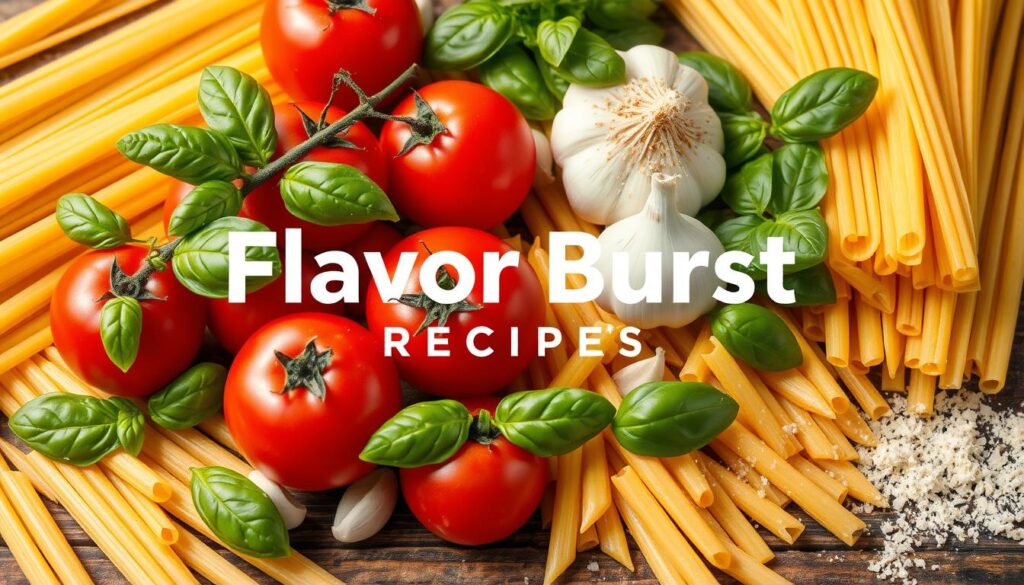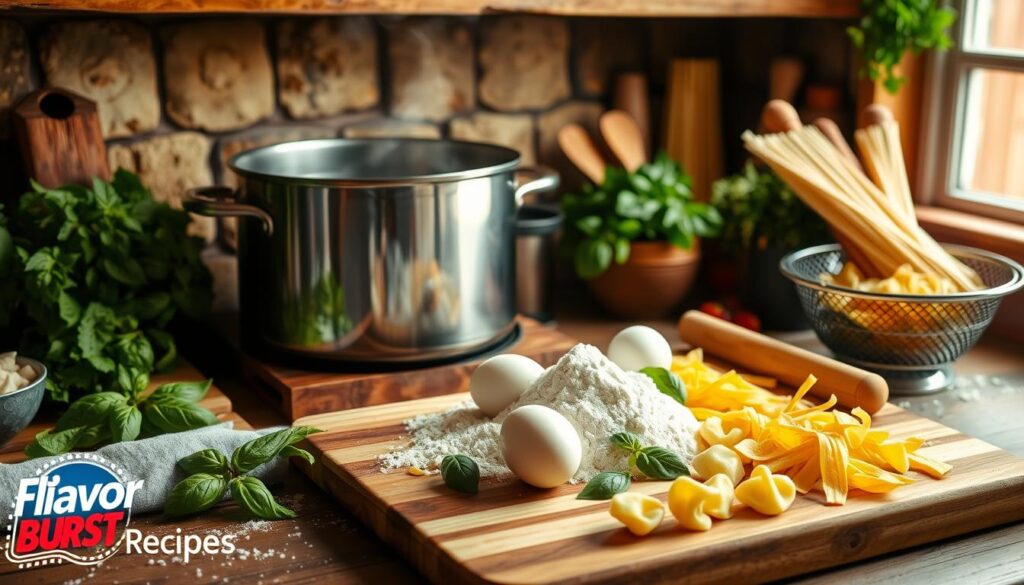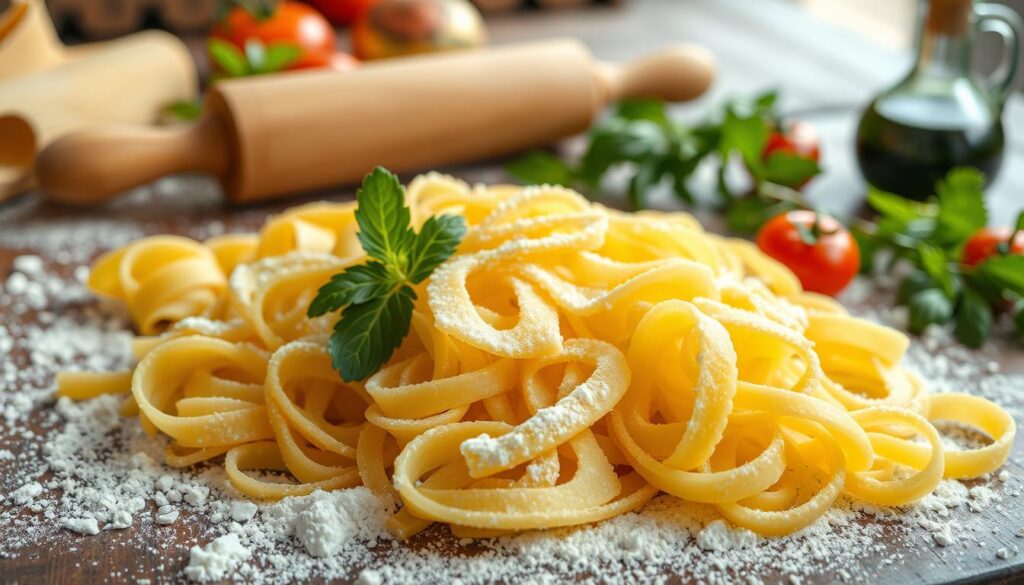Dive into the world of Italian cuisine and explore classic Italian pasta recipes. This guide celebrates the art of homemade pasta and its role in Italian culinary heritage. Learn how to make exceptional Italian pasta dishes that will take you to Italy.

Key Takeaways
- Discover the rich history and cultural significance of Italian pasta-making traditions.
- Master the essential ingredients and techniques for crafting authentic Italian pasta dishes.
- Explore a variety of classic recipes, from traditional Carbonara to the beloved Bolognese.
- Learn the differences between fresh and dried pasta, and when to use each for best results.
- Discover the origins and versatility of popular Italian pasta sauces.
- Explore vegetarian and quick-and-easy pasta options to suit various dietary preferences.
- Pair your pasta dishes with the perfect Italian wine for a truly memorable dining experience.
Table of Contents
Understanding the Rich Heritage of Italian Pasta Making
Pasta is more than a food in Italy; it’s a tradition that spans centuries. It has shaped the country’s culinary identity. Exploring Italian pasta making reveals a fascinating story for food lovers.
Regional Traditions and Their Influence
Italy’s regions each bring their own twist to pasta. This creates a rich mix of flavors and techniques. Each region has its own pasta shapes, sauces, and cooking methods, shaped by local ingredients and traditions. For example, the Emilia-Romagna region is proud of its Bolognese ragu. Meanwhile, Liguria is famous for its pesto alla Genovese.
Historical Evolution of Pasta in Italy
Pasta’s origins date back to ancient times, but Italy made it what it is today. Over time, Italian pasta has changed with new ingredients and cooking methods. From spaghetti and ravioli to today’s artisanal varieties, Italy’s pasta story shows its culinary creativity and strength.
Cultural Significance in Italian Cuisine
Pasta is deeply rooted in Italian culture. It goes beyond being just food. It’s a part of Italian family life, with meals and recipes shared for generations. Making and enjoying pasta together connects Italians to their heritage. It celebrates regional identities and builds community. Authentic Italian pasta dishes are more than food; they’re a way to come together.
Essential Ingredients for Authentic Italian Pasta Dishes
Creating delicious Italian pasta dishes starts with the right ingredients. High-quality semolina flour and rich extra virgin olive oil are key. Each ingredient is crucial for a perfect pasta experience. Let’s explore the must-haves for authentic Italian cuisine.
At the core of Italian pasta is the flour. Semolina, a coarse wheat flour, gives pasta its perfect texture. Its high gluten content makes dough hold its shape, ensuring a great bite.
Eggs are also vital. Fresh, free-range eggs add richness and structure to the dough. They help bind ingredients together with semolina flour, making pasta tender yet resilient.
No Italian kitchen is complete without extra virgin olive oil. It adds a unique flavor and is essential for cooking. From sautéing veggies to finishing dishes, its versatility is unmatched in Italian cooking.
Using fresh, seasonal ingredients is crucial for enhancing flavors. Juicy tomatoes and fragrant basil can turn simple pasta into a masterpiece.
As you explore authentic Italian pasta, focus on ingredient quality. Mastering these essentials will bring Italy to your table with every bite.

Must-Try Classic Italian Pasta Recipes
Discover the world of authentic Italian pasta recipes. Try classics like Carbonara, Bolognese, and Pesto alla Genovese. These dishes show Italy’s rich culinary heritage.
Traditional Carbonara
Carbonara is a favorite from Rome. It combines egg yolks, Pecorino Romano, and crispy guanciale with hot pasta. It’s a rich and indulgent dish.
To make it just right, balance the ingredients. This will give you the perfect Carbonara.
Authentic Bolognese
Bolognese comes from Emilia-Romagna. It’s a meat sauce for thick pasta like tagliatelle. It’s slow-cooked with beef, pork, and veggies.
This creates a deep, complex flavor. It’s a comforting dish.
Classic Pesto alla Genovese
Pesto alla Genovese is from Genoa. It’s a fresh sauce with basil, pine nuts, garlic, and Parmesan. It’s great with spaghetti or linguine.

“Pasta is the staff of life.”
– Sophia Loren, Italian actress and icon
Mastering Basic Pasta Cooking Techniques
To cook pasta perfectly, you need to learn a few key cooking techniques. Whether making a classic homemade pasta dish or trying new Italian cuisine recipes, these skills are essential. They help your pasta turn out just right, al dente and full of flavor.
- Salting the Pasta Water: The right amount of salt in the water is key for flavor. Use about 1 tablespoon of salt for every 4 quarts of water.
- Cooking to Al Dente Texture: Pasta should be firm but tender. Cook it for 8-12 minutes, then check if it’s just right.
- Reserving Pasta Cooking Water: Always save some of the starchy water. It’s great for thinning sauces and adding a smooth texture.
- Matching Pasta Shapes with Sauces: Choose the right pasta for your sauce. For example, long pasta like spaghetti goes well with light sauces. Short pasta like penne is better with thick sauces.
Learning these basic cooking techniques will help you make amazing homemade pasta dishes. Your creations will truly capture the spirit of Italian cuisine.
| Pasta Shape | Best Sauce Pairings |
|---|---|
| Spaghetti | Tomato, Pesto, Carbonara |
| Penne | Arrabbiata, Vodka, Amatriciana |
| Farfalle | Pesto, Cream-based Sauces |
| Fusilli | Ragu, Pesto, Vegetable-based Sauces |

“The secret of good pasta is to cook it al dente. For the best texture, the pasta should have a slight bite to it when you eat it.” – Lidia Bastianich, Italian-American chef and restaurateur
Fresh vs. Dried Pasta: Making the Right Choice
Choosing between fresh and dried pasta can greatly affect your Italian dishes. Knowing the differences between them helps you pick the right one for your recipes.
Benefits of Fresh Pasta
Fresh pasta adds a luxurious touch to any dish. It’s made by kneading, rolling, and cutting the dough. This makes it tender and perfect for soaking up sauces. Plus, it cooks fast, ideal for quick meals.
When to Use Dried Pasta
Dried pasta is great for its convenience and versatility. It’s firmer and works well with thick sauces. It also lasts longer, perfect for your pantry.
Storage and Preparation Tips
- Keep fresh pasta in the fridge and use it within a few days for the best taste.
- Dried pasta can stay good for months in a cool, dry spot. It’s always ready for your pasta dishes.
- Always cook pasta as directed to get the right texture and taste.
Whether you make your own fresh pasta or use high-quality dried pasta, knowing their differences is key. It helps you make the most authentic and tasty Italian pasta dishes.

Popular Italian Pasta Sauces and Their Origins
Explore the rich world of Italian cuisine and the stories of its beloved pasta sauces. From Alfredo’s creamy delight to Arrabbiata’s zesty kick, each sauce has its own history. These stories highlight the flavors of Italy, shaped by regional influences.
Let’s dive into the origins and what makes these iconic sauces special:
- Alfredo – This sauce comes from Rome and is known for its richness. It’s made with butter, Parmesan cheese, and sometimes cream. It’s perfect with long pasta like fettuccine.
- Marinara – From Campania, Marinara is a classic tomato sauce. It’s bright and tangy, great with many pasta shapes, from spaghetti to penne.
- Pesto alla Genovese – This sauce is from Genoa and is full of fresh flavors. It’s made with basil, garlic, pine nuts, and Parmesan cheese. It’s best with trofie or trenette pasta, celebrating Genoa’s cuisine.
- Arrabbiata – From Lazio, Arrabbiata is spicy and tangy. It’s made with tomatoes and chili peppers. It’s great with short pasta like penne, holding its bold flavors.
Learn the stories of these and other classic sauces. It will take your cooking journey through Italy’s diverse regions.
Vegetarian Italian Pasta Options
Italian food has many tasty vegetarian pasta dishes. These dishes show off the great flavors and textures of plants. Try these vegetarian pasta options and add fresh produce and herbs to make healthy, Italian pasta recipes that taste amazing.
Seasonal Ingredients Guide
Italian cooking follows the seasons closely, and vegetarian pasta is no different. Using fresh, local ingredients makes your pasta dishes taste better and be healthier. In spring, use asparagus, peas, and greens. Summer brings tomatoes, zucchini, and basil. Autumn offers mushrooms, squash, and kale.
By using what nature gives us, you can make delicious Italian pasta recipes all year round.
Meat-Free Classic Variations
- Vegetarian Bolognese: Replace ground beef with lentils, mushrooms, or plant-based protein for a meatless version of this classic.
- Pesto alla Genovese: Mix basil, pine nuts, garlic, and Parmigiano-Reggiano to make a vibrant, dairy-free pesto that goes well with pasta.
- Vegetarian Carbonara: Use a creamy sauce of cashews, soy milk, and nutritional yeast to make a vegan version of this dish.
| Vegetarian Pasta Dish | Key Ingredients | Flavor Profile |
|---|---|---|
| Roasted Vegetable Lasagna | Eggplant, zucchini, bell peppers, spinach, ricotta, mozzarella | Hearty, comforting, packed with seasonal vegetables |
| Penne alla Norma | Penne, eggplant, tomatoes, garlic, basil, ricotta salata | Vibrant, tangy, and slightly smoky |
| Spaghetti alle Vongole (Clams) | Spaghetti, cherry tomatoes, garlic, white wine, parsley | Bright, briny, and full of Mediterranean flavors |
Discover the world of vegetarian pasta and find endless ways to make tasty, healthy, and Italian pasta recipes that are good for you and delicious.
Quick and Easy Italian Pasta Recipes
Italian pasta dishes are perfect for weeknight meals. They’re easy to make with simple ingredients and basic techniques. Here are some quick and tasty Italian pasta recipes that are easy to make.
Creamy Garlic Pasta
This creamy garlic pasta is a favorite in Italy. It’s ready in just 30 minutes. Mix cooked pasta with garlic, heavy cream, Parmesan, and lemon. Top it with parsley for a fresh look.
One-Pot Spaghetti Bolognese
Try this one-pot spaghetti Bolognese for a comforting meal. It’s made with ground beef, tomatoes, and veggies. Just add pasta to the pot and cook until it’s done.
Lemon Basil Pasta
This lemon basil pasta is light and refreshing. It’s great for warm weather. Mix cooked pasta with lemon-garlic sauce, basil, and Parmesan. It’s quick and flavorful.
| Recipe | Prep Time | Cook Time | Total Time |
|---|---|---|---|
| Creamy Garlic Pasta | 10 minutes | 20 minutes | 30 minutes |
| One-Pot Spaghetti Bolognese | 15 minutes | 30 minutes | 45 minutes |
| Lemon Basil Pasta | 10 minutes | 15 minutes | 25 minutes |
These Italian pasta recipes are quick and easy. They show how simple and versatile Italian cooking can be. Enjoy authentic flavors any night with these recipes. Bon appetit!
Pairing Wine with Your Italian Pasta Dishes
Adding the right wine to your Italian pasta can make the flavors pop. It’s like taking a trip to Italy with every bite. Whether it’s a classic Carbonara or a local favorite, the right wine can make the meal even better.
Red Wine Selections
For dishes like Bolognese or Amatriciana, choose a bold red wine. A Chianti Classico or Montepulciano d’Abruzzo is perfect. They bring out the sauce’s richness and balance the acidity.
White Wine Recommendations
- For creamy dishes like Alfredo or Carbonara, try a crisp Pinot Grigio or a zesty Sauvignon Blanc. They offer a nice contrast.
- Pesto-based dishes, like Pesto alla Genovese, go well with a fresh Vermentino or a lively Verdicchio.
Regional Wine Pairings
Discover wines from different Italian regions to find the best match for your pasta. For instance, Spaghetti alle Vongole from Campania pairs well with Lacryma Christi del Vesuvio. Meanwhile, Pasta alla Norma from Sicily is enhanced by Nero d’Avola.
When pairing wine with pasta, think about the flavors, textures, and where they come from. With a bit of exploration, you’ll find the perfect wine to enhance your Italian meal.
Conclusion
Italian pasta is a mix of regional traditions, history, and culture. You’ve learned about pasta-making heritage and key techniques. This journey into authentic Italian cuisine is exciting.
You’ve tried classic dishes like Carbonara, Bolognese, and Pesto alla Genovese. You’ve also learned about fresh versus dried pasta. Now, you can make Italian flavors at home. The secret is using high-quality ingredients and preparing them with care.
Keep exploring Italian pasta specialties, seasonal foods, and wine pairings. This will deepen your love for Italian cuisine. With a passion for heritage and a spirit of adventure, you can make your own Italian pasta recipes. Enjoy the journey into the world of Italian cuisine that has won hearts globally.
FAQ
What are the key ingredients for authentic Italian pasta dishes?
For real Italian pasta, you need top-notch semolina flour and eggs for fresh pasta. Add extra virgin olive oil, salt, and sometimes Pecorino Romano or Parmigiano-Reggiano cheese. Using fresh, seasonal ingredients boosts the taste of traditional pasta recipes.
How do I choose between fresh and dried pasta for my Italian recipes?
It’s up to you whether to use fresh or dried pasta. Fresh pasta is great with creamy sauces, while dried pasta is better for tomato sauces. Fresh pasta is softer, while dried pasta holds up to thicker sauces. Think about the sauce and texture you want when picking your pasta.
What are some must-try classic Italian pasta recipes?
You should try Carbonara, Bolognese, and Pesto alla Genovese. These dishes highlight the rich flavors and regional specialties of Italian pasta.
How can I master the basic techniques for cooking pasta?
To cook pasta well, start by boiling the water and salting it. Cook the pasta until it’s al dente. Save some starchy water for your sauce. Match the pasta shape with the right sauce for the best taste and texture.
What are some healthy and vegetarian Italian pasta options?
For healthier pasta, try vegetable sauces, legume-based pasta, and whole-grain or gluten-free options. Use fresh herbs, roasted veggies, and plant-based proteins for nutritious, tasty pasta dishes.
How can I pair wine with my Italian pasta dishes?
Choose wine based on your pasta’s sauce. For tomato sauces, pick a light to medium red wine like Chianti. Creamy or pesto pasta goes with crisp white wines like Pinot Grigio. Try wines from the pasta’s region for a true Italian taste.
